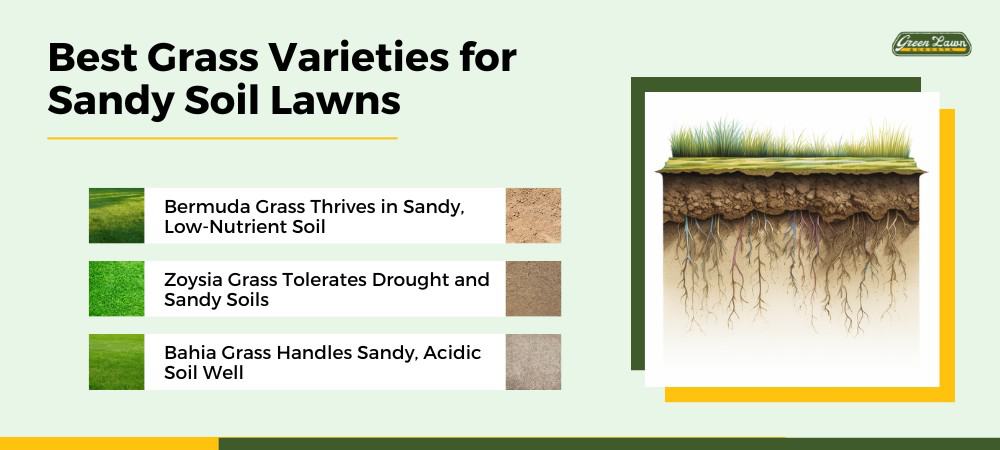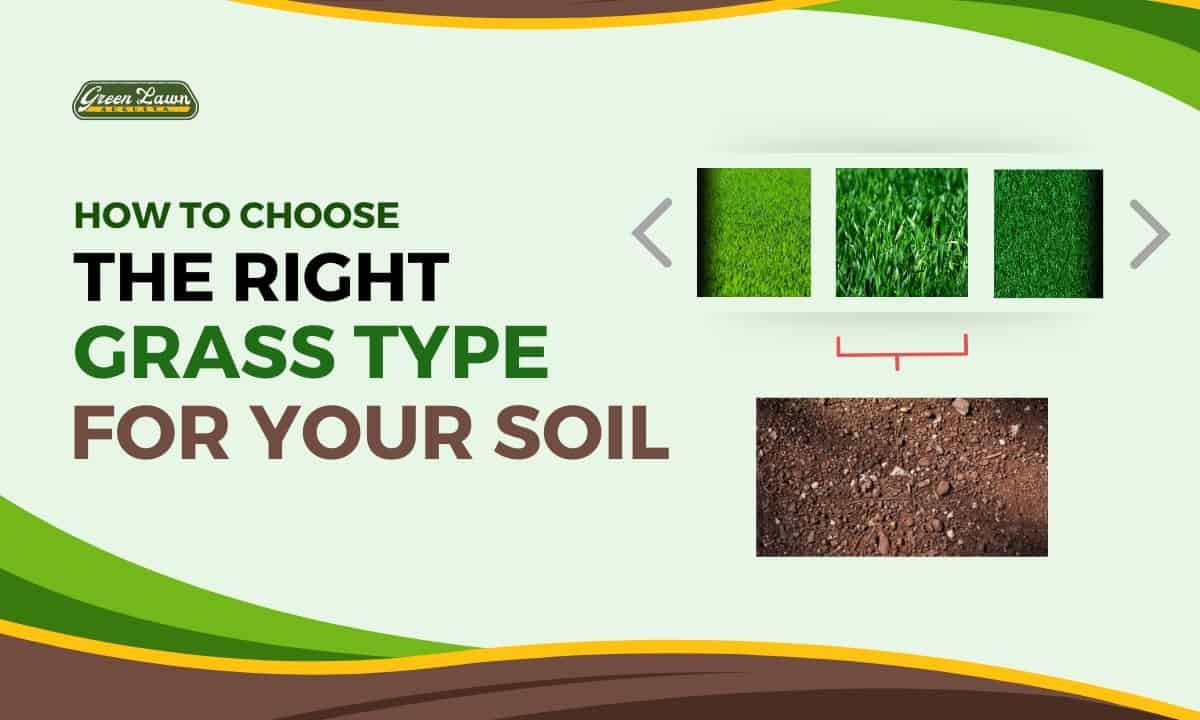Choosing the right grass type for your soil; it’s about the enviroment around your yard.
The type of soil has a significant impact on the growth of grass. Sandy, clay, and loam soils all have distinct effect
Understanding the Importance of Soil Type for Grass Selection (Sandy, Clay, Loam)
Before selecting grass for your home, it is crucial to test the pH level of your soil. To check for acidity or alkalinity, soil testing kits are easily available at gardening centers.
Understanding soil texture and its impact on grass growth is equally important. Sandy soils drain fast but lack nutrients. Clay soils retain moisture but can get compacted—loam soils balance drainage and nutrient retention.
For healthy grass growth, it’s important to have good drainage.
Choose grass varieties based on soil fertility for best growth. Some types thrive in low-nutrient soil.
Lastly, Be mindful of soil compaction in high-traffic lawn areas. Certain grasses tolerate it better than others.
Best Grass Varieties for Sandy Soil Lawns

For those grappling with sandy soil conditions in their lawns, Bermuda, zoysia, or Bahia grass are ideal choices.
Bermuda grass is resilient, flourishing even in sandy, nutrient-poor soil.
Zoysia grass, on the other hand, is drought-tolerant and exhibits a preference for sandy substrates.
Bahia grass exhibits a non-selective growth pattern, thriving on sandy, acidic soil.
Bermuda Grass Thrives in Sandy, Low-Nutrient Soil
Bermuda grass is ideal for sandy, nutrient-poor soil. It can withstand dry conditions and prevent erosion with its strong roots. To grow it well, provide adequate water and fertilizer.
However, to keep a healthy Bermuda grass lawn, maintain proper mowing height, watering, and pest control to prevent lawn grubs and leaf spot disease.
Zoysia Grass Tolerates Drought and Sandy Soils
Zoysia grass is ideal for sandy soil and drought-prone areas. Its deep roots improve soil drainage and transform sandy lawns Into a Lush, Low-Maintenance Xeriscape.
Zoysia grass needs slightly acidic soil with a pH range of 6 to 6.5 for optimal growth. Adjust soil acidity with lime or sulfur.
Opt for Zoysia and witness your lawn’s remarkable transformation.
Bahia Grass Handles Sandy, Acidic Soil Well
Bahia grass thrives in sandy, acidic soil due to its toughness and low maintenance requirements. Its ideal environment is one with good drainage and pest resistance.
For added nutrients, use organic matter or slow-release fertilizers.
| Grass Type | Soil Type | Maintenance |
| Bahia | Sandy, Acidic | Low |
| Zoysia | Sandy, Acidic | Moderate |
| Bermuda | Sandy, Acidic | High |
For homeowners looking to achieve a perfect lawn quickly, professional sod installation Augusta, Ga offers an effective solution tailored to the local environment.
Grass Types Suited to Clay Soil and Wet Conditions

Consider Fescue, St. Augustine, or Centipede grass for clay soil and damp areas.
Each species possesses a distinctive capacity to flourish in these challenging conditions.
Fescue Grass Performs Well in Clay Soil
Fescue grass thrives in clay soil because its deep roots absorb moisture and nutrients, making it a great option for heavy soil.
To ensure optimal growth of your fescue lawn, follow these guidelines:
- Enhance Drainage: Integrate organic matter into soil to avert water stagnation.
- Halt Soil Erosion: Aerating your lawn regularly will help preserve soil structure.
- Choose Suitable Fertilizers: A balanced diet is preferred by fescue; a slow-release, balanced fertilizer is advisable.
- Regulate Soil pH: Test your soil’s pH for fescue growth success.
Boost root growth for a healthier lawn by overcoming clay soil barriers with these tactics.
St. Augustine Flourishes in Wet, Clay Environments
St. Augustine grass thrives in moist clay soil and hot and humid climates, preventing soil erosion. Good drainage is important to maintain a healthy lawn.
Choose a fertilizer that promotes the growth and texture of St. Augustine grass. This strengthens your lawn, making it resistant to pests and creating a thriving ecosystem.
Having St. Augustine grass is both effortless and aesthetically pleasing.
Centipede Grass Grows Well in Poor, Clay Soil
Centipede grass is your ally in such challenging environments, solving persistent lawn problems.
To optimize its performance, consider the following steps:
- Enhance Drainage: Improving clay soil drainage prevents water-logging and promotes root health.
- Regulate soil pH: Centipede grass thrives in acidic soil. Test the soil pH and adjust as needed.
- Appropriate Fertilization: Centipede grass requires minimal care and is not reliant on heavy fertilization. Over-fertilization can be harmful.
- Alleviate Compaction and Manage Weeds: Aerating soil helps roots grow strong, while mowing and using herbicides reduces weeds.
Adopting centipede grass into your lawn management routine can make a difference.
Grasses That Grow Best in Loam Soil

You’re favored if you possess loam soil because numerous grass types flourish in it.
Top contenders include Kentucky Bluegrass, known for its affinity for nutrient-dense loam, and Perennial Ryegrass, appreciated for its preference for balanced conditions.
Tall Fescue performs remarkably well in deep, loamy soil.
Kentucky Bluegrass Loves Nutrient-Rich Loam Soil
Kentucky bluegrass species yearn for a nourishing environment, and given the appropriate conditions, they foster substantial roots and a thick turf carpet.
Adhere to these four critical steps:
- Enhancing soil fertility: Incorporate compost or other organic matter to bolster nutrient content.
- Regulating soil pH: Evaluate and balance the soil’s pH to optimize Kentucky bluegrass growth between 6.0 and 7.0.
- Organic soil amendments: Substances like manure or compost can elevate the soil’s structure and fertility.
- Assessing soil composition: Routine testing is essential to monitor nutrient content and pH levels, ensuring optimal growth conditions.
Perennial Ryegrass Does Well in Loamy Soil
Perennial ryegrass is durable for high foot traffic areas, prevents soil erosion, and thrives in loamy soil.
However, maintain healthy soil for optimal ryegrass growth by regularly testing pH levels and adding necessary lime or sulfur.
Remember that the thriving of your perennial ryegrass is inextricably linked to the condition of your soil.
Tall Fescue Thrives in Deep, Loamy Soil
Tall fescue is great for nutrient-rich, loamy soil, making it a smart choice for your lawn.
Here are four comprehensive tips for selecting the right grass type:
- Enhancing Soil Fertility: Tall fescue thrives best in nutrient-rich loam soil, which can significantly improve soil fertility.
- Opting for Grass in Dry Conditions: Its deep root system makes it resilient in dry conditions, making it an excellent choice.
- Selecting Grass for Acidic Soil: Fret not if you have acidic soil; tall fescue is well-equipped to withstand these conditions.
- Mitigating Soil Compaction and Erosion: The dense growth pattern of tall fescue helps to manage soil compaction and prevent erosion.
This selection strategy will empower you to bolster the health and aesthetics of your lawn.
Improving Soil Quality to Support Healthy Grass

To grow healthy grass in tough soil, start by aerating to loosen it up.
Aerating Compacted Clay or Sandy Soil
Aerating compacted soil promotes deeper root growth and improves drainage.
Here’s the recommended approach:
- Determine the nature of the soil you’re working with.
- Select the aeration method best suited to your soil type.
- Implement this method at the ideal time for your grass variety.
- Perform the aeration based on your soil’s degree of compaction.
Proper aeration methods can promote healthier grass growth based on soil and grass type.
Amending Soil Nutrients for Stronger Grass
Understanding how to amend soil nutrients is crucial for growing healthy grass in your yard. Soil fertility management involves identifying nutrient deficiencies and using appropriate strategies to correct them.
To meet the nutrient needs of different types of grass, use organic soil amendments like compost, manure, or bone meal. They provide essential nutrients such as nitrogen, phosphorus, or potassium.
It’s essential to regularly test soil pH and nutrient levels to create a healthy environment for thriving grass.
Diagnosis and Treatments for Lawn Diseases
To fix lawn issues, identify the problem and take appropriate measures. Inspect visually and evaluate soil. Grass type and soil conditions are important factors when managing lawn diseases.
Use natural solutions like a mixture of baking soda and water to control lawn ailments like powdery mildew. In severe cases, consider using fungicides or insecticides.
Regular care, including watering and mowing, can prevent many lawn diseases. Keep your lawn healthy and vibrant.
Expert Grass and Soil Services

Green Lawn Augusta offers expert lawn treatment in Augusta and specializes in identifying and treating problems, providing personalized weed control and fertilization based on your grass type and soil conditions.

